My experience with Cambo goes back to my days at the turn of the millennium working for SinarBron Imaging, the USA Importer for Sinar cameras at the time. Most of the studio 4×5 shooters that I came into contact with were using a Sinar or a Cambo (occasionally a Toyo…). If they used a Cambo they were spending only 50% – 70% the price of the Sinar. That is how Cambo was initially imprinted into my psyche, as the “value” brand.

But in recent years, Cambo’s place in my compendium universe has changed from “value brand” to “premium brand”. Or, considering their price points, maybe premium just doesn’t sound right, so then I’m back to “value brand”, which doesn’t seem to match the amazing quality of their products, especially of late, where they have literally outdone themselves, so I am left with “frigging bargain brand”. I don’t know, we’ll let the marketing folks figure that out.
In the meantime, after having spent a few weeks in July with a prototype model of a new product, we have now received the first shipping version of this product from Cambo called the Actus. Cambo has had a busy year – with things both large and small. Large news arrived earlier this year with the arrival of the world’s first technical camera that includes a built in geared sliding back, the Cambo WRS600.
But now with the big news past, time for some really, really small news with the Cambo Actus.
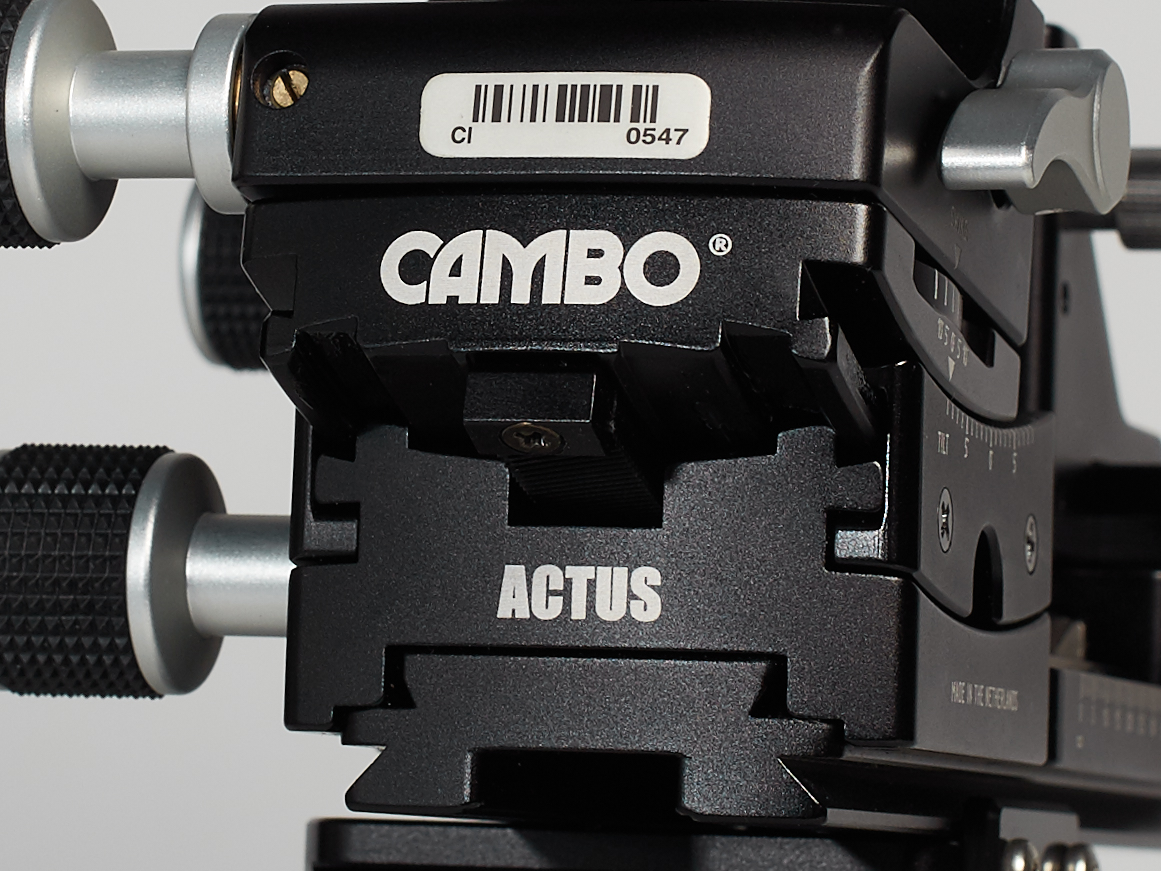
What could this be?
For reference, the Cambo Actus derives some lineage from the Cambo X2 Pro.
The X2 Pro is a fantastic camera with built-in tilt/shift movements that allows one to mount digital cameras like Canons, Nikons, even Mamiya 645 medium format cameras with digital backs attached, and pair those with a variety of lenses from Hasselblad, Mamiya, Schneider, Rodenstock, etc. One caveat to the X2 Pro was size and a rather unconventional footprint, so portability was a challenge, but most were using it in the studio anyway. Included among the many pluses for the X2 Pro was the ability to apply shift/tilt/swing movements to the above mentioned lenses with a variety of cameras. However, due to the size of the addendum camera, and the distance this presented between the imaging plane and the rear optic, most view camera lenses wider than 70mm were a no go for infinity focusing.
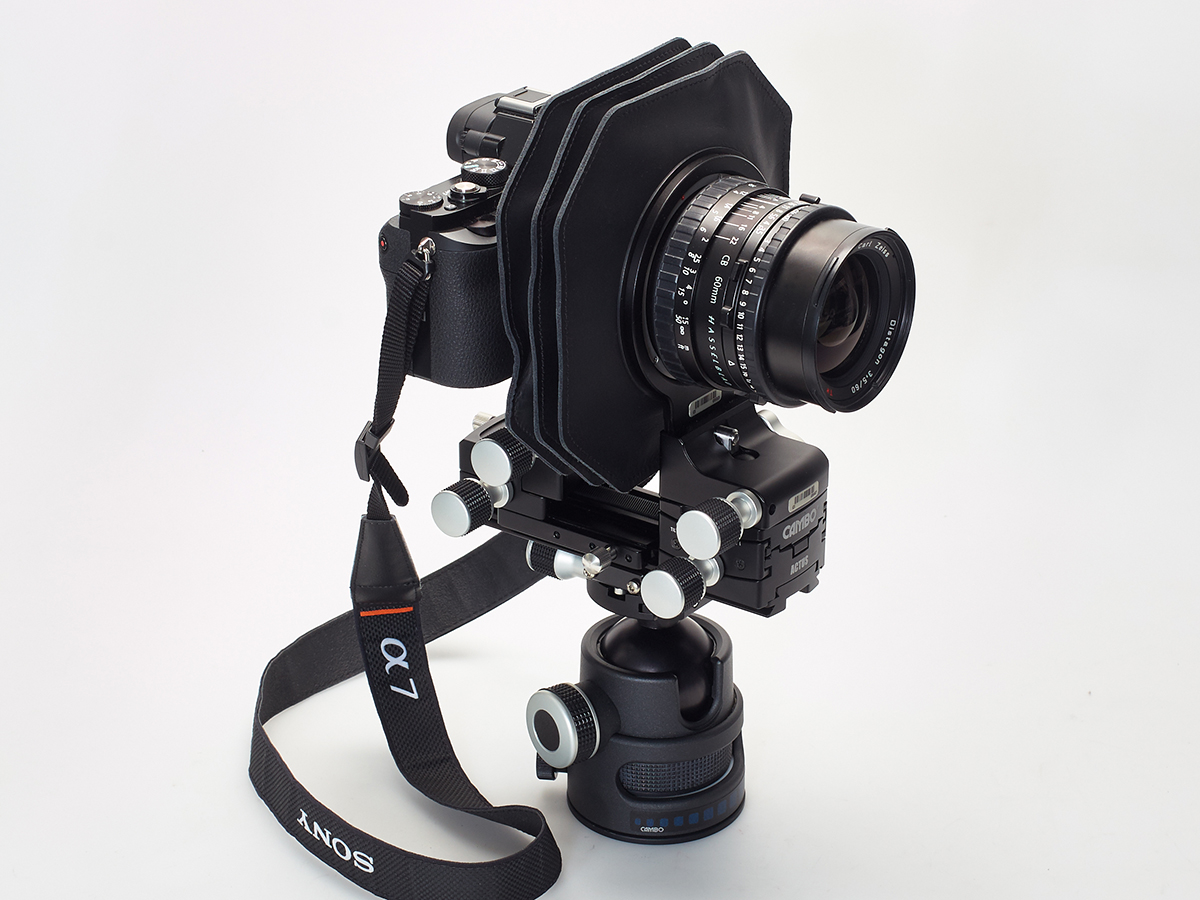
Oh, now I see – it’s a Cambo Actus. Is that a Hasselblad lens?Some years later, enter the Cambo Actus. Think – a very miniaturized version of an X2 Pro, with a more conventional view camera shape but an incredibly tiny footprint. Literally more like a very tiny little view camera. What in the world was Cambo thinking? They were thinking big thoughts….about small things.
View cameras are not supposed to be this small! They really aren’t. First off, what can be cooler than rolling out one of those ginormous 11 x 14 view cameras? And part of what the ample size of these creatures brings forth is room to fit in all types of advanced gearing and self arresting mechanisms. You can’t really do that professionally with a little camera that is only about 3 inches wide. Or can you?
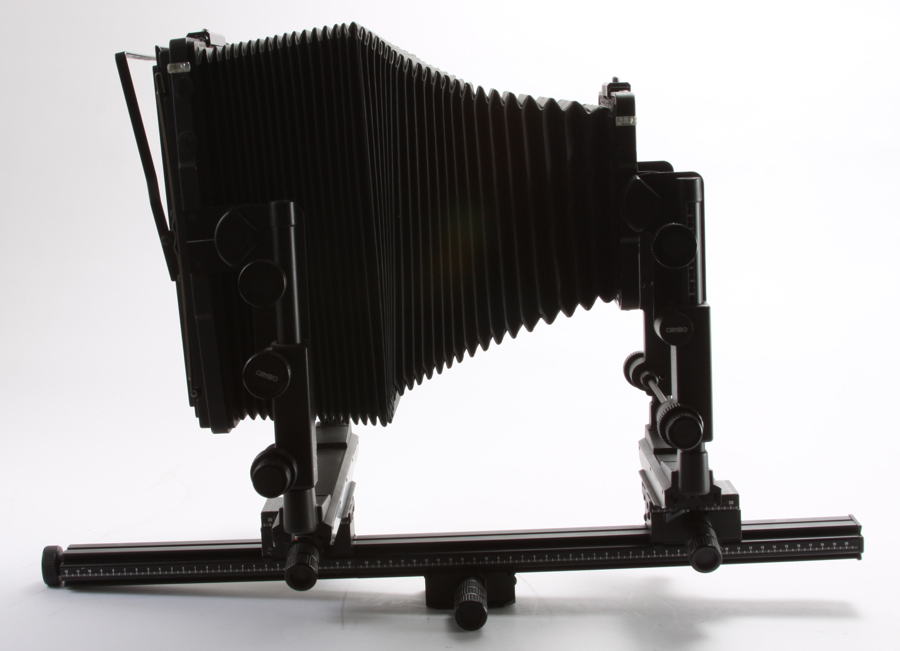
I wonder how much this weighs?
To some degree, Cambo has indeed performed this trick. While they have not included self arresting movements, they have engineered an ample amount of movement with fine gearing and ease of use in a product that’s barely the size of a Coke can! So let’s see potentially how much we can get away with. As we’ve seen with Apple, making small, precise things that work simply and look nice is incredibly difficult. But somehow, the Actus combines all of that in one go. Now, the quick specs that matter:
- Weight is approximately 1000 grams (2 lbs, 3 ounces for non-metricals)
- Horizontal rear shift of 20mm/20mm
- Vertical rear shift (rise/fall) of 12mm/15mm
- Front swing of 360 degrees (that could look interesting)
- Front tilt of 22 degrees, (12/10 degrees)
- Arca Swiss compatible base rail
Let’s now take a very close look at what Cambo has delivered. As you can see, Cambo’s fine machining is at play here as we look at some of the individual components. Note that there will be 2 different color options. The standard version is black anodized, but optionally there is the Titanium version (I shall capitalize that), which is a sort of lustrous silver/gold. Honestly, don’t you have enough black cameras? Another question – can they be mixed and matched when ordering? Really? really? Don’t…. just don’t.
Movement, I got movement!
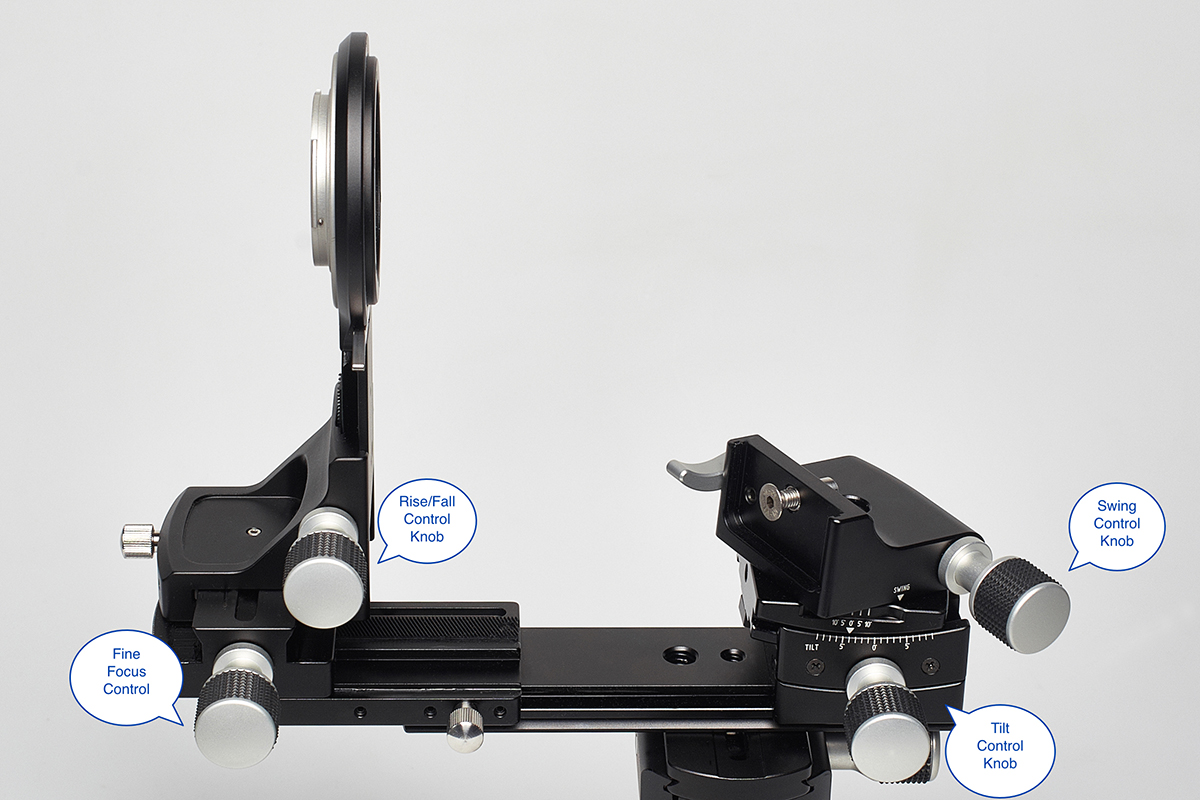
We love ergo friendly grip knobs
All right then, so let’s talk about these movements and how you, well…..do them. East/west horizontal shift is 20mm in each direction. These are not geared movements, but the action of freely sliding the rear standard left to right and vice versa is smooth and controlled. And as an added bonus, there are detents at the 0 and 10mm positions. I love detents! For those who are wondering what a detent is, it means you can place the position of the shift with your eyes closed, as you feel a concrete dip at the detented positions, and you know where you are. It’s just very easy – and I feel like I’m going to use the word “easy” many many times in this article.
The rise/fall control has no scale, but there are 3 detents at 10mm/0/12mm (bottom, middle, top). Your swing control is 360 degrees. So, perhaps you could play around with shooting through the front optic of your lens! Or not… At any rate, both the swing and tilt movements are geared, scaled and work easily. The tilt movement is considered an axis tilt, which doesn’t mean it is evil (far from it!), it simply means that the tilt axis occurs centrally in the middle portion of the lens, which minimizes the need for additional focus adjustments.
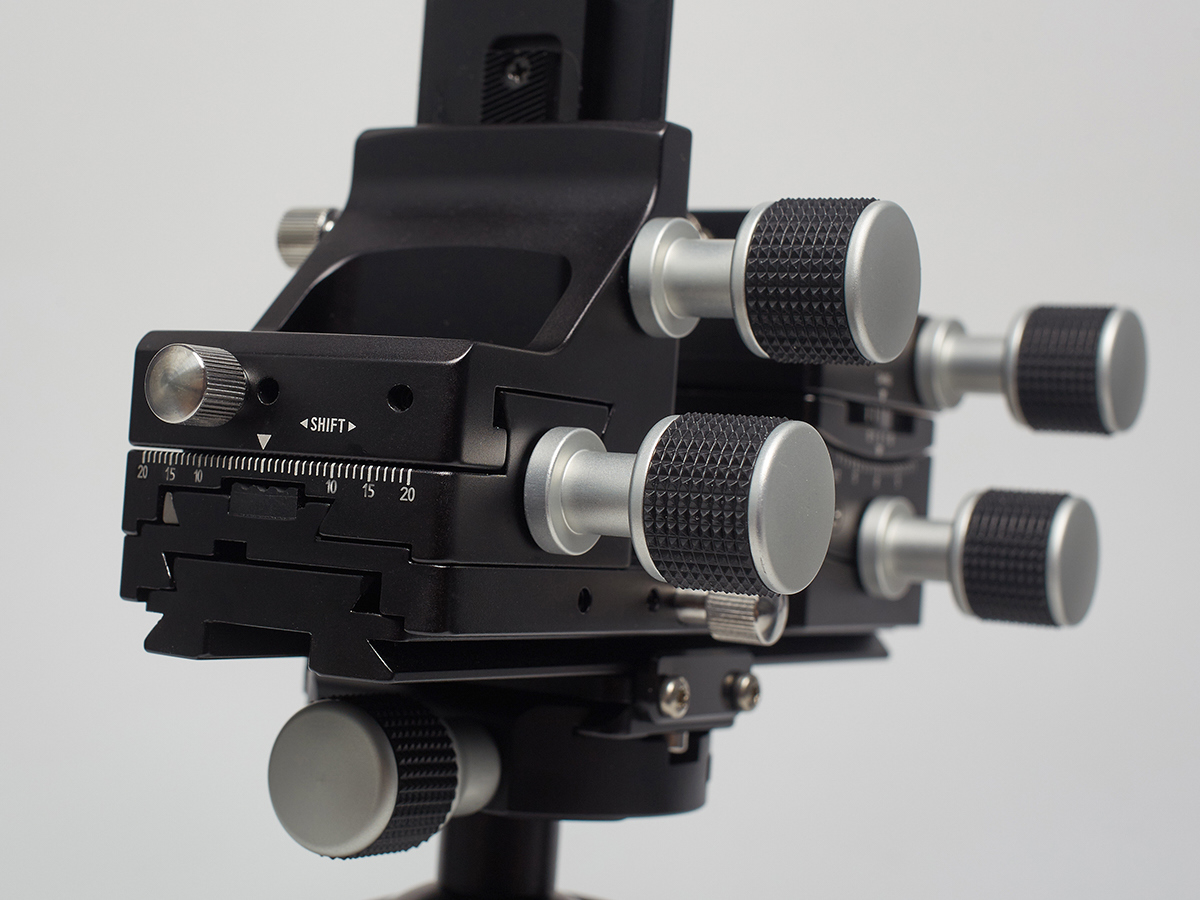
20mm to the left of us, 20mm to the right of us
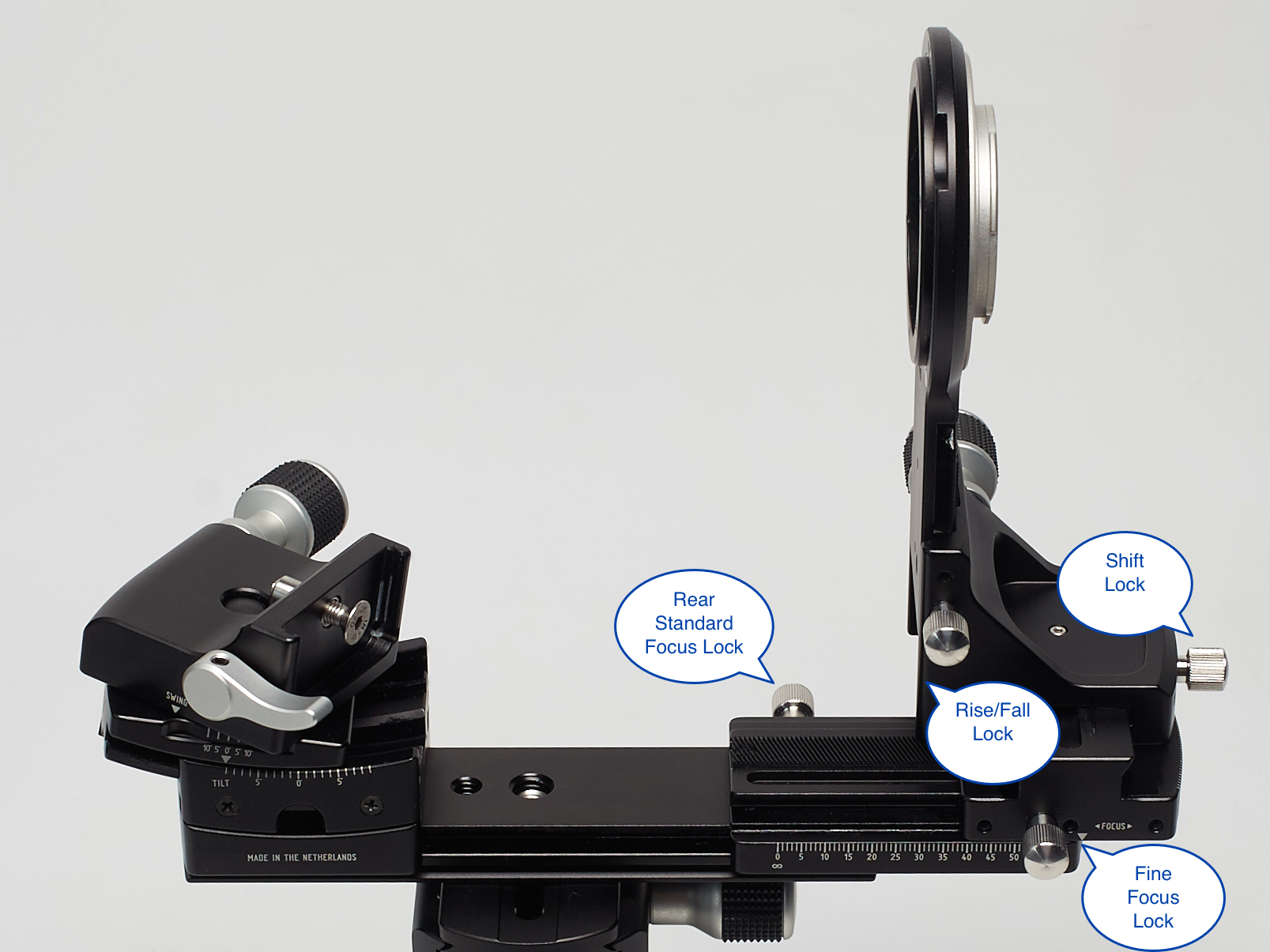
Lock the knob and it stays put. Brilliant!
Besides all these movement possibilities, one must also remember that your Sony/Canon/Nikon camera isn’t going to be doing the focusing, the Cambo Actus is – and you’re going to have your hands on the wheel(s). You have two methods for focus adjustments, a sliding rail-based rear standard focus to get the range of it, and a fine focus knob for precisely dialing in that focus point. All of the rear movements – the east/west horizontal and north/south vertical shift movements, the rear standard and fine focus adjustments, are lockable with unobtrusively friendly locking knobs. Beware – yes, you can unscrew the locking knob until it actually is removed completely, so don’t loosen it a lot. Just enough to free up the movement.
Mounting cameras to the Cambo Actus
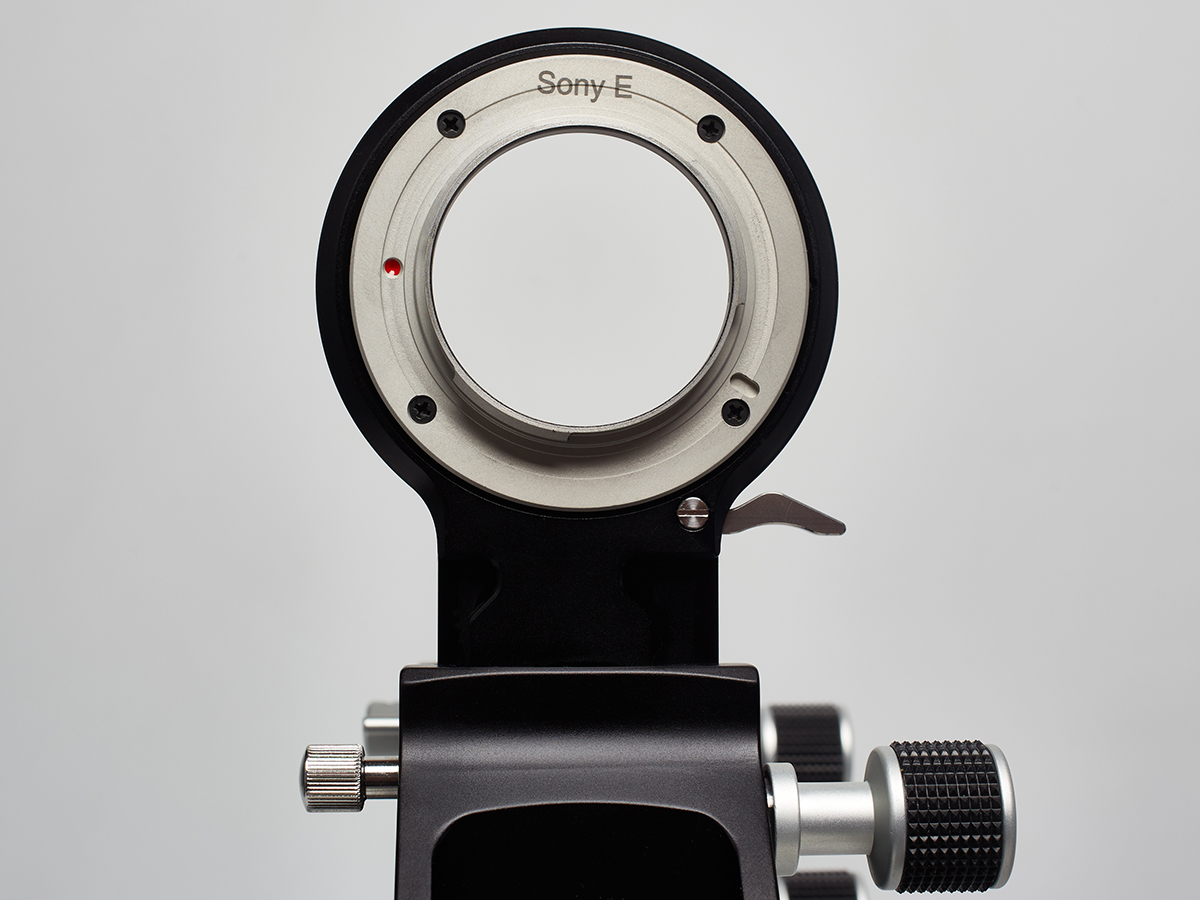
The Sony A7 Camera Mount
Your camera mount options are Sony, Canon, Nikon, Fuji, Micro 4/3. You can order pre-configured to the camera mount of your choice, although the camera mount is a small plate that can be ordered separately (you might be wise enough to own more than one camera that can mount to the Actus). In the case of the pictured Sony plate above, after trying unsuccessfully to attach the plate via the supplied 4 screws, I thought – Oh no! Cambo has somehow smudged the Sony mounting plate. Stupid, stupid thought! Brain cramp #1 – the 4 screws are not all equal distance to each other. I had the plate positioned so that the screw holes in the plate didn’t line up with the screw holes in the rear standard. So that is the first puzzle one must grapple with. Resourceful as I am, this did not keep me down long, and soon I had the Sony A7R mounted on the rear standard.
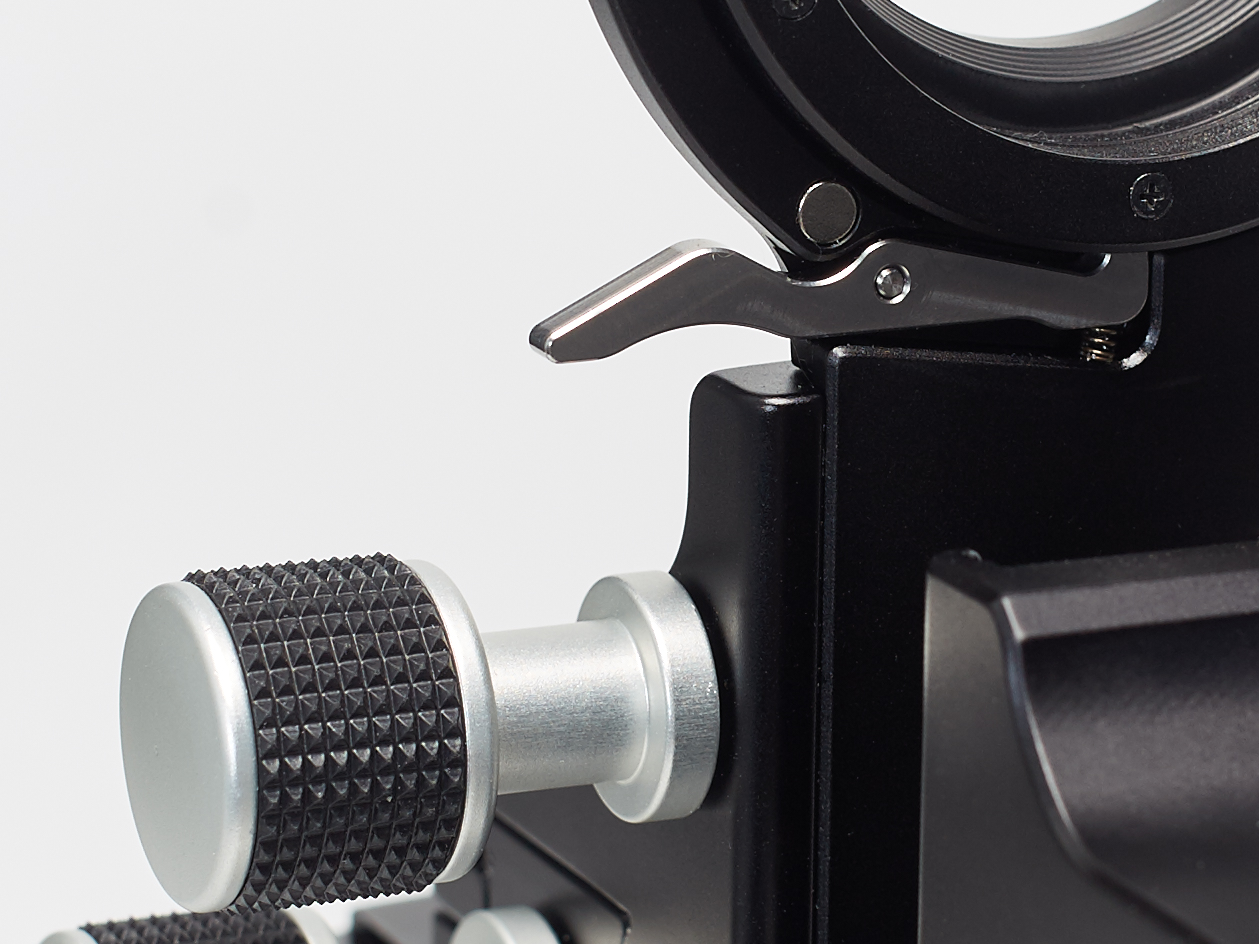
The camera rotation lever is handy, minimal, effectively functional
In the great halls at Cambo, the designers, in their wisdom, determined to supply a rotational lever for orienting the camera from horizontal to vertical perspective – all without removing the camera body (and thereby exposing that sensor to the sinister dust molecules of the world). Using this lever is so mindlessly easy, I really cannot believe they didn’t make it harder. Pull the lever and the camera smoothly changes orientation. Too easy! Challenge us, Cambo! We’re used to it!
Mounting Lenses to the Cambo Actus
More nuggets of genius await. There’s lots of ways to mount a lens to a camera. How would Cambo approach this task? The early prototype I played with featured two screws that easily attached the lensboard to the camera. However, the final version provides a radically different solution.
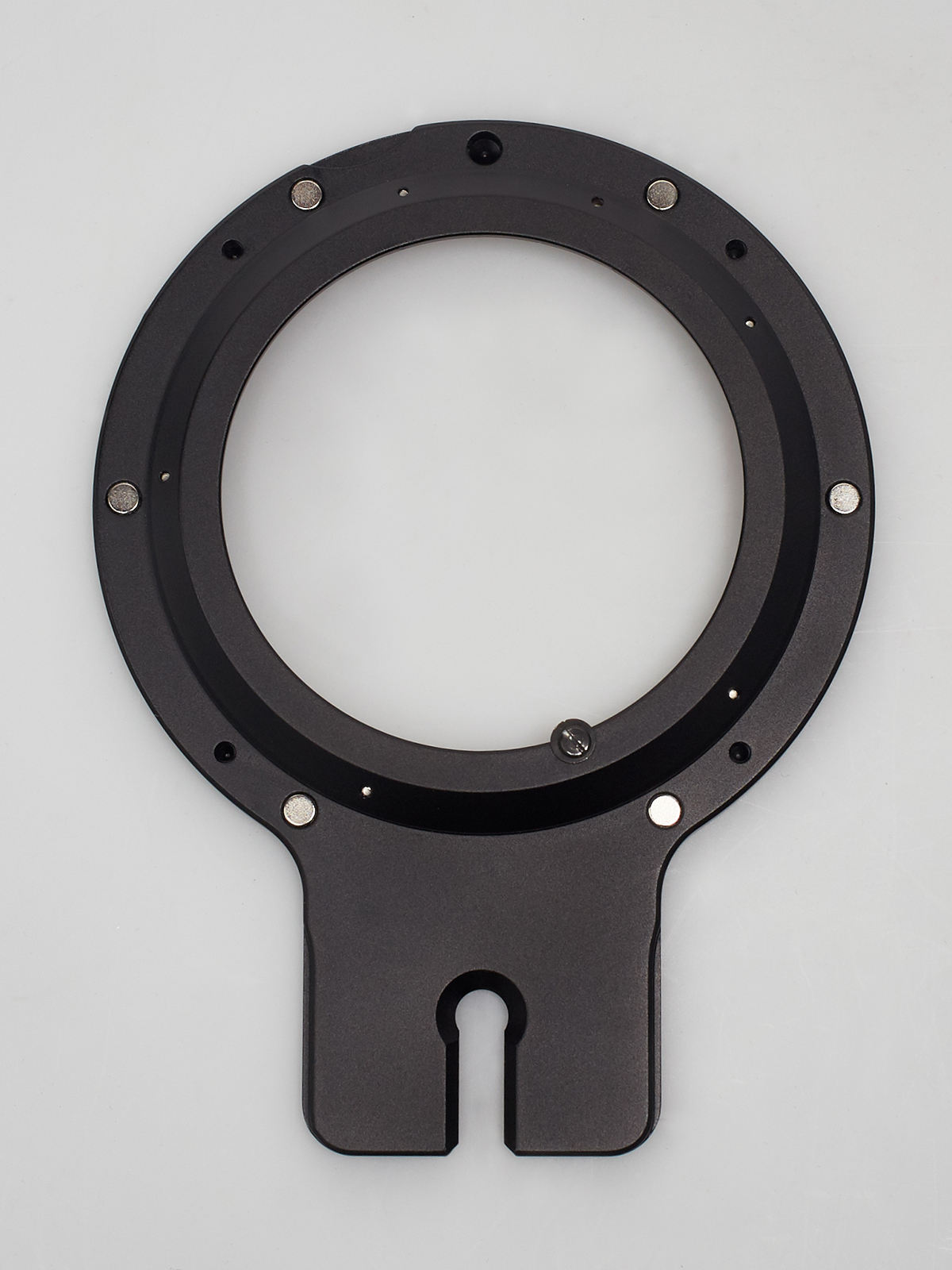
I’m referring to a shape on the lensboard I call the “sliding fork”. This sliding fork settles over a protracted screw, which is then pulled tight with a handy little lever. The lever action pushes the screw outward to give room for the sliding fork lensboard, then the lever is reversed forward, with no resistance until the very end. And at that stage, there is a very pronounced settling click. The key to this is the consistency with which this securing of the lensboard feels like. You know when you have it, and based on the cost of some of the lenses you might mount to this camera caravan, that is very important.
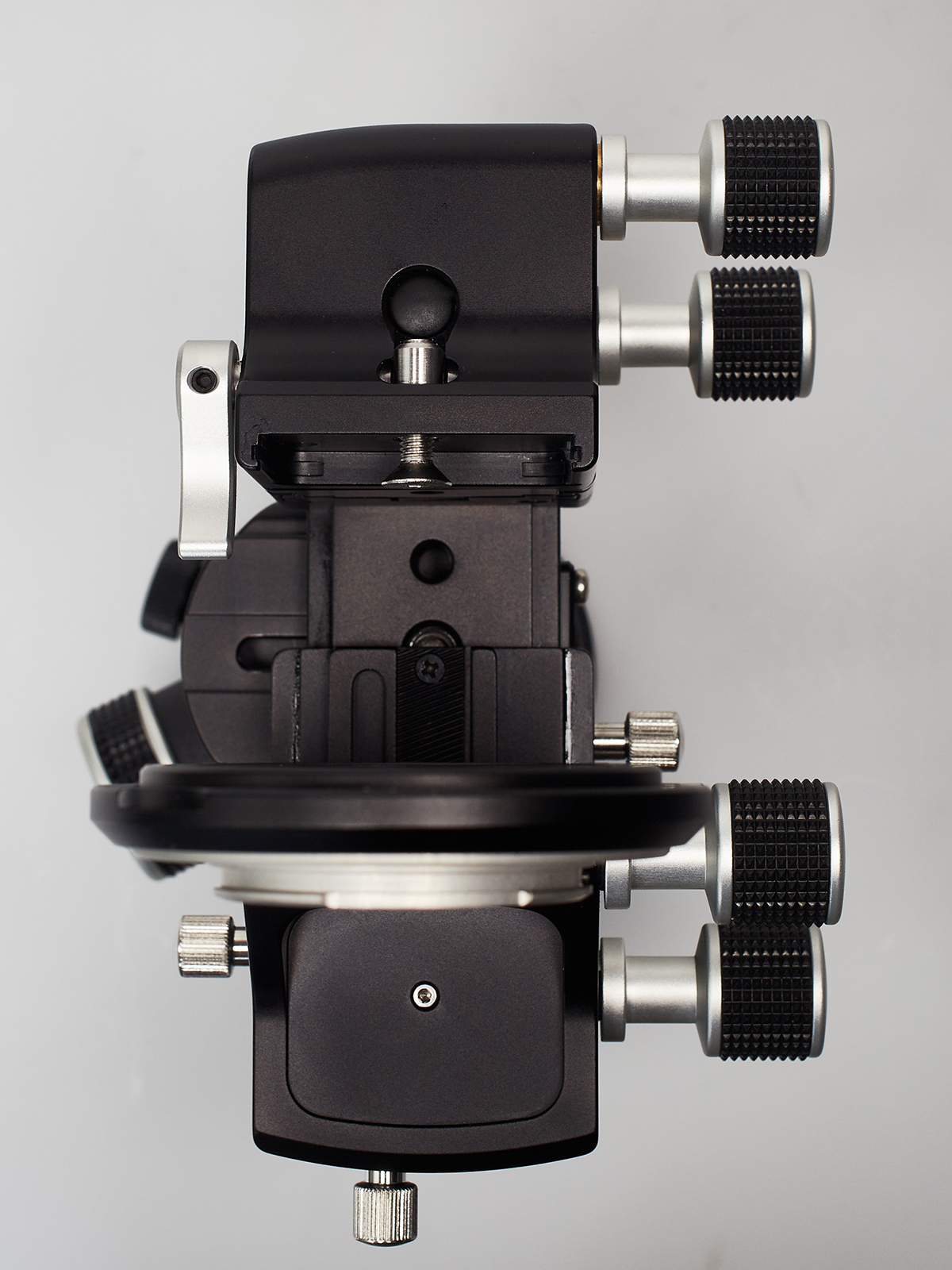
Simple, simple, simple – the protracted screw for lensboard placement
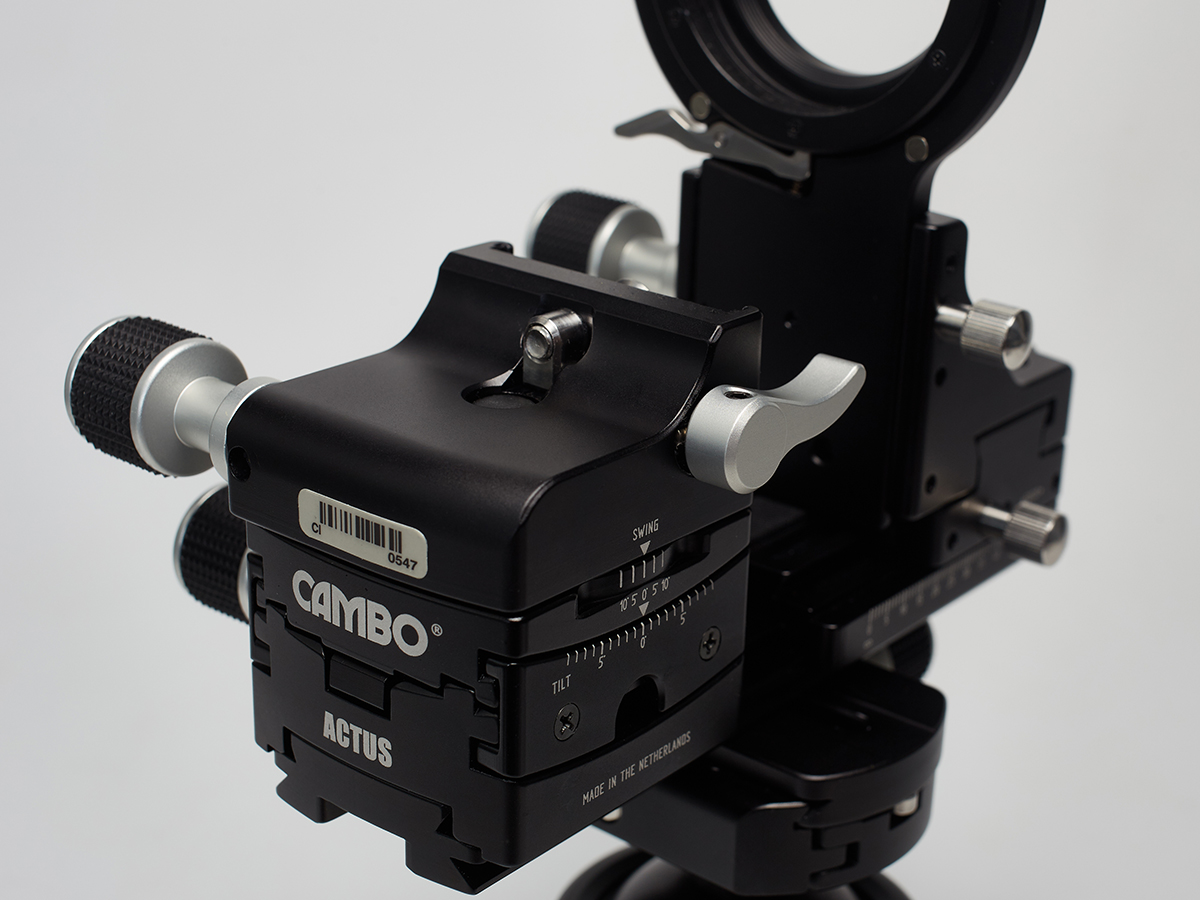
Flip the switch and you’re good to go
Of course, all view cameras share at least one common trait, among others, and that is a bellows. The bellows acts as a light seal and extends or contracts to allow magnification, focus, etc, by allowing the front and rear standard (the lens position and the digital camera position) to come closer or further away from each other, whichever the need requires. The bellows for the Cambo Actus secures itself magnetically! A magnetic bellows!?!? Why hadn’t someone thought of this before? Why have we suffered all these years, grappling with the tendon twisting tangle that is otherwise known as securing the bellows to the front and rear standards of a view camera? Oh, because magnets strong enough to secure a 4×5 bellows might also automatically re-cock the shutter due to their gravitational pull? For now, that question remains unanswered, but what matters is that the Cambo Actus, perhaps due to its small size, has simplified the installation and removal of bellows,much to the relief of millions, err, well… perhaps thousands, who have struggled with clipping that (#*$%)@*$)%@!()%# bellows into place all these years. If for no other reason, rejoice for that!

This single protruding nub guides the position
But regardless, Cambo has again supplied the simple, easy answer – because in many respects, this is what Cambo does. This is who they are as a company. They create effortless, simple, practical solutions to photography.
So now that we’ve made our formal introductions, how practical is this little guy? We’ve seen the promise of the X2 Pro, shrinking that potential by such a magnitude surely introduces some compromises. Well, that it does. But these compromises are mainly targeted at a user base the X2 Pro didn’t really point toward, the scenic or landscape shooter. Due to the X2 Pro’s inability to shoot with wide lens focal lengths – on account of the mirror-stuffed camera bodies that sat on the rear of the X2 camera – the primary X2 Pro user was a table top shooter, and for this application the X2 Pro made perfect sense. But the Actus accepts mirror-less bodies, and so, wide – or at least wider – lenses are back on the menu. Combined with the small size, this means the Actus, paired with say, a Sony A7R, screams, let’s go outside and play!
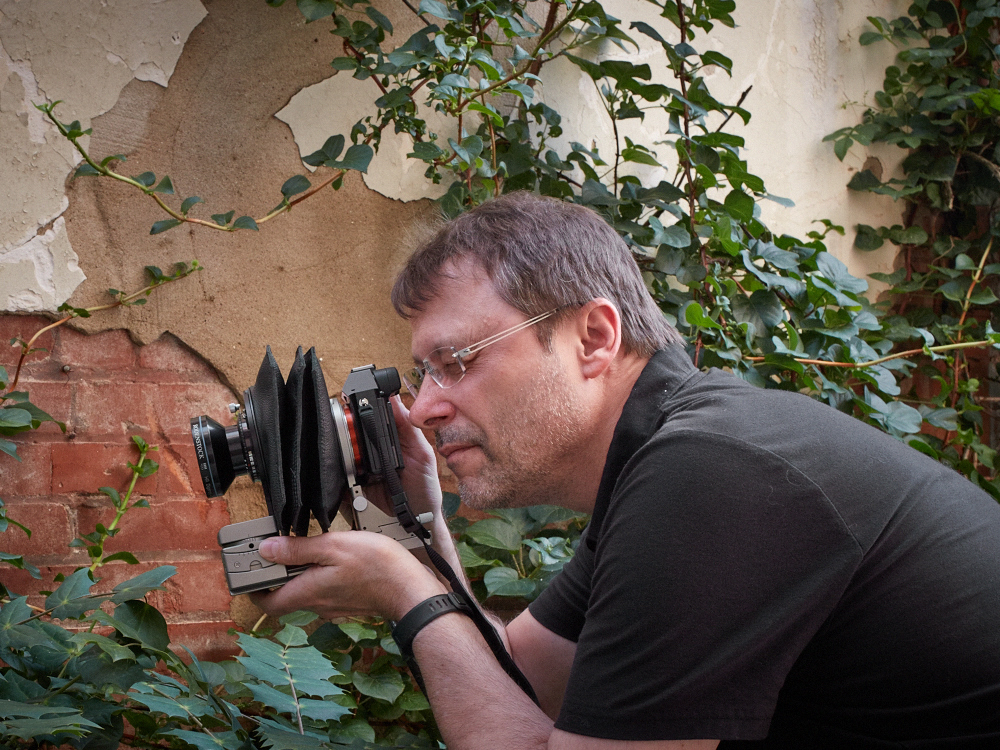
At just a few pounds, the Cambo Actus is hand holdable!
And so what challenges await there? Well, a Sony A7R is a 36 megapixel sensor. No, not an 80 megapixel beast, but nothing to be trifled with. It is a considerable amount of pixels, and those pixels must be rendered with care – especially when you combine them with a camera capable of the shift and tilt/swing movements the Actus brings around.
There is a critical difference between a little view camera and a helical focusing technical camera, which has no second standard to mess about with for vertical forward and backward focusing, hence fewer methods to get yourself into trouble.
http://205.186.138.113/plesk-site-preview/captureintegration.com/205.186.138.113/cambo/cambo-wide-rs-5000/
The tilt and swing and vertical/horizontal shift knobs on the Actus are all in different places, but they all are the same type of knob. Very different from the controls on the technical cameras, which feel more uniquely deliminated, are self-locking, and fewer of them, to boot. Because the Actus provides locking mechanisms for north/south/east/west shift, north/south focus and north/south fine focus, you’ve got 4 additional small knobs to keep up with in a condensed space. What all this means is that it is much easier to get yourself in trouble with the little Actus. So you have to keep your head in the game! In practical terms what this means is that you might be so transfixed by the gorgeous scene you’re capturing with your wonderful little Cambo that you forget to tighten up one of the locking knobs, say the rear standard focus, and let’s say you barely nudge that rear standard and the forgotten lock is not holding it. Now – it only moved a smidgeon – but you’re capturing 36 million pixels of data and the slightest bit turns your beauty from prize winner to a mulligan.This is not the fault of Cambo. If you want a small view camera, some things cannot be practically supplied while preserving the diminutive scale.
Then, there is the matter of the lenses themselves. We’re venturing into uncharted territory here. While we did not have on hand anything wider than a Schneider Kruznach 47mm APO Digitar, along with a Rodenstock 50mm HR, both these lenses showed some limitations as evidenced by the LCC captures below when employing close to the maximum movement available.

LCC Capture on Sony A7R & Cambo Actus, Rodenstock 50mm HR, 12mm rise, 15mm shift
And it’s very important to realize that these are not extreme wide lenses, and on a Canon or Nikon or Sony 36mm x 24mm sensor, they are actually not wide at all. A 50mm is a 50mm, so I’m shooting with a normal lens. So the movements and potential stitched shots are really going to be essential for anyone wanting to produce scenic vistas. Below, you see that stitching these 3 shots together with the 50mm Rodenstock HR Lens has given me about a 34mm equivalent.

Atlanta Eye, 3 shot horizontal stitch, Rodenstock 50mm HR
So how do we shoot wider without stitching? Or even with stitching? The good news is that Cambo has innovated at this late stage in the game by producing a modification to the Actus in which they replace their conventional rear standard with a modified version that slightly reduces the flange distance by:
– Creating a permanently attached and embedded bellows
– Omitting the rotating mechanism for camera position
This further reduction allows for the use of the following lenses, among others:
– Rodenstock 32mm HR W Digaron
– Schneider 35mm XL APO Digitar
– Rodenstock 35mm HR S Digaron
– Rodenstock 40mm HR W Digaron
In addition to those lenses, the Actus will also enable the use of Leica R and legacy Nikon F lenses. Now you may have your wides after all. This modified rear standard should be ready to go toward the end of August. Will there be some limitations on how much you can get away with shifting these lenses, especially the SK 35mm Digitar? Based on what we’ve seen with the Rodenstock 50mm HR and Schneider 47mm Digitar lenses, it would be prudent to not expect much movement with these wider lenses. We’ll find out more when we get the final shipping product with the modified rear standard and throw some wider lenses on there.
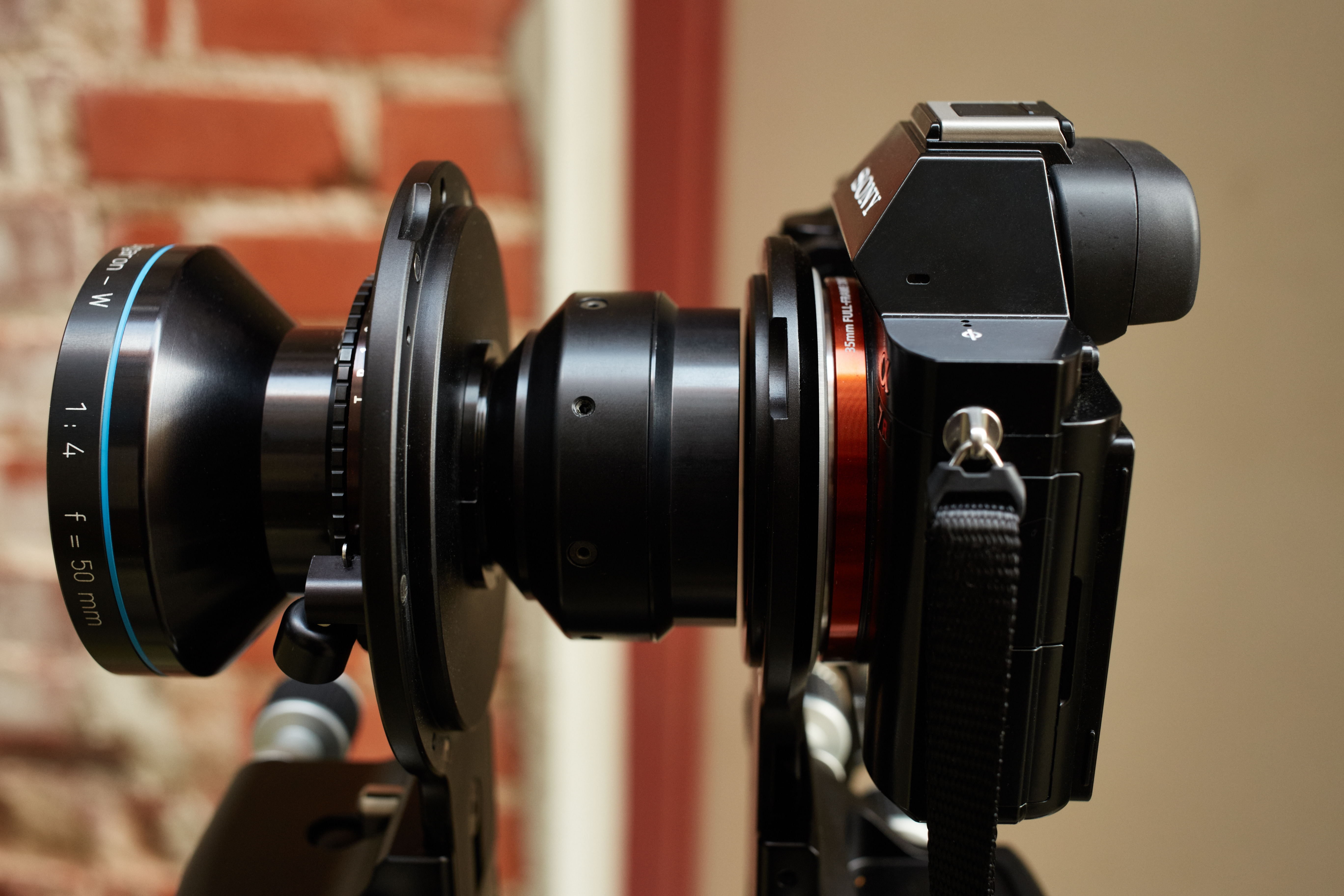
When the stakes are high, the margins are slim
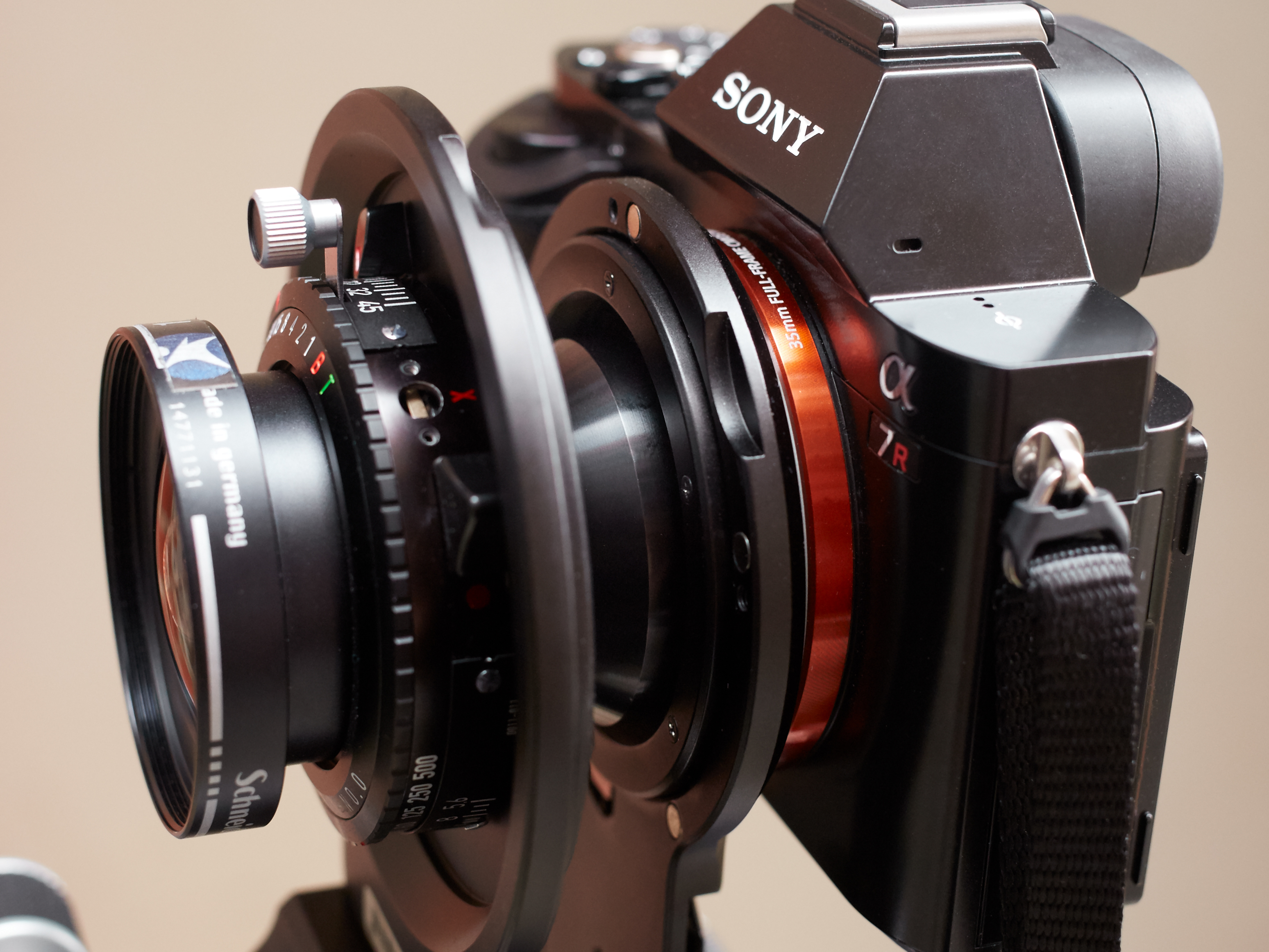
Open Wide??
As you can see above, for infinity focus, the Rodenstock 50mm HR is right up against it, while the Schneider 47mm has gone right into the tunnel! The Schneider 35mm Digitar will have to travel even further toward the sensor. Well this isn’t necessarily a downside….except for one thing. To shift wider than 5mm or so, well……that’s pretty tricky! Because you’ll have to pull the lens back out, then adjust your shift position, then refocus. On these wide lenses and their close proximity to the sensor, shifting may be a challenge regardless of how much you can get away with. So in some cases, you may have better results with the medium longer lenses than the wides, in terms of pure angle of view, due to the rear optic position, large image circle, and ease of shifting clearance.
But what about the lenses themselves – in terms of pure resolution with sensors that feature pixel sizes down to 4.88 microns? Before we dive in there, we will note that our evaluation of lens performance with various digital camera sensors is an ongoing project, as we encounter different lenses in our inventory, as we receive requests and recommendations, we’ll put lenses to the test. For now, we grabbed a handful of lenses and tried to get an idea of how well they resolve the data that is propelled into the Sony 36 megapixel, 4.88 micron per pixel CMOS sensor. For this test, our approach diverged from our normal approach, which might include shooting a landscape. We wanted to remove as many variables as possible – wind, changing exposures, the impact of lens curvature on focus position, etc. So for these tests, we have a studio target captured with ProFoto strobes. The results were …. surprising.
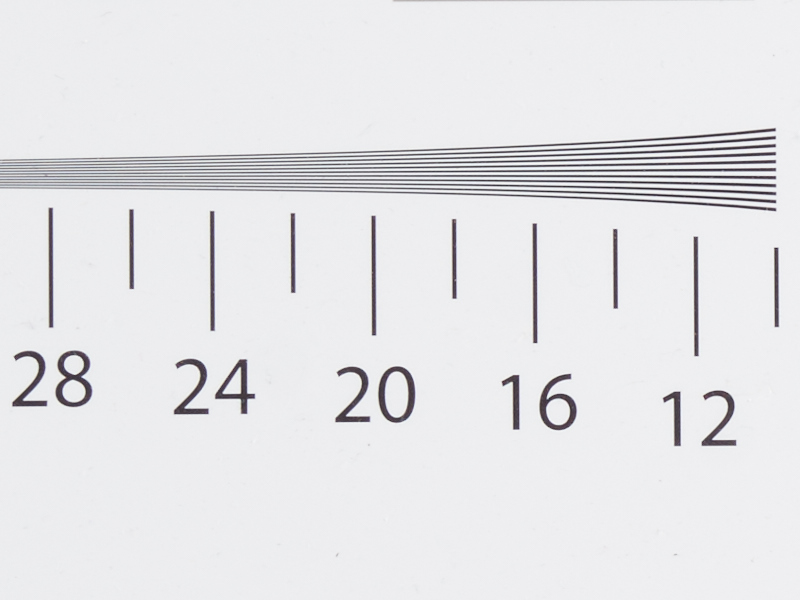
Rodenstock 50mm HR Digaron Center, zero mm position
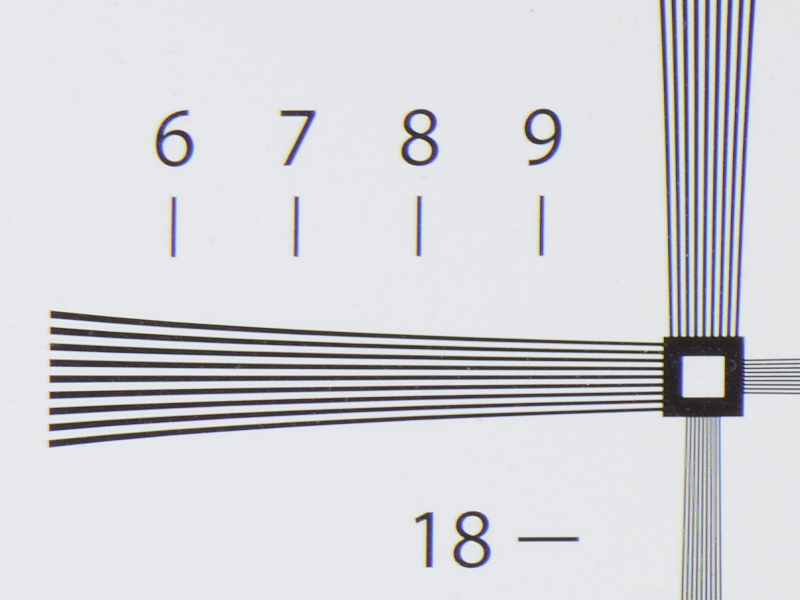
Rodenstock 50mm HR Digaron, 15mm shift
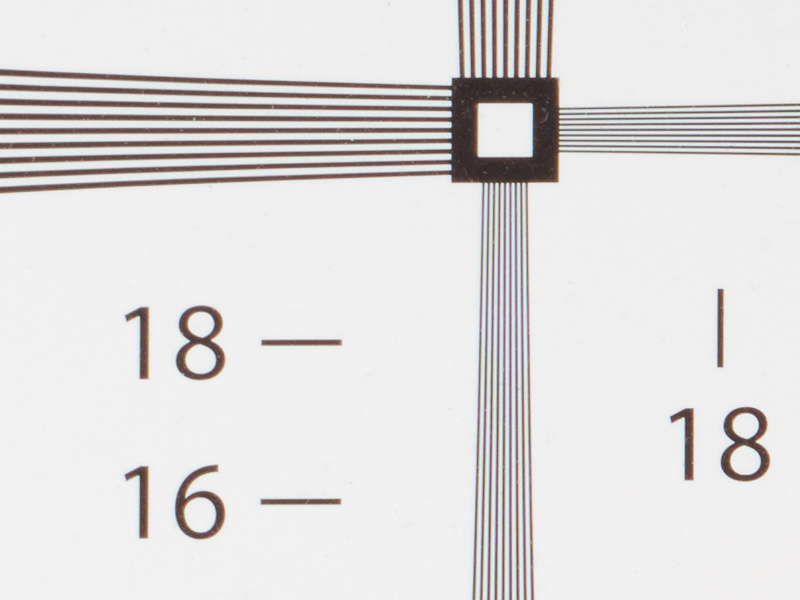
Hasselblad 60mm CB, zero mm position
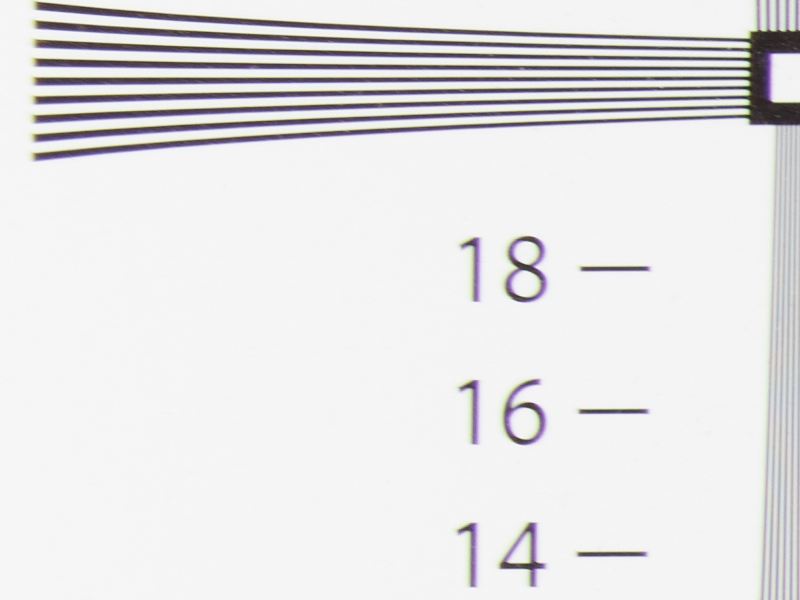
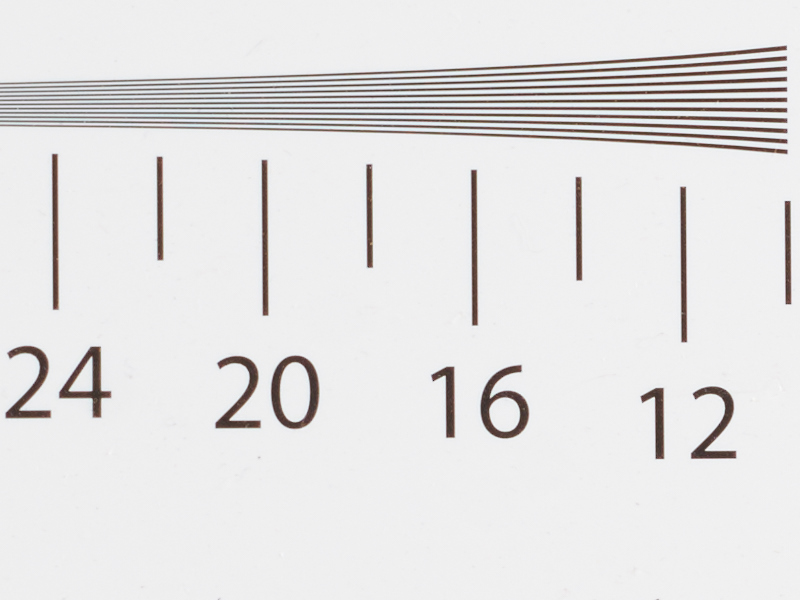
Rodenstock 75mm Grandagon, zero mm position

Rodenstock 75mm Grandagon, 15mm shift right
I’ve never been one to automatically discard a “non-digital” lens. Our experience has been that analogue wides are often challenged by the most current CCD/CMOS sensors (and there are exceptions here), but that medium and longer lenses are worth a try as they can often surprise. Such was the case above with the 75mm Grandagon, with good results from center to edge, even at 15mm shift. Keep in mind these files are un-retouched, default settings, no lens corrections for chromatic aberrations, no contrast, no extra sharpening adjustments have been made. As mentioned, over time we will produce further performance results for lens and camera combinations.
And so that wraps up this review of the now shipping Cambo Actus…..
But waaaiiittt!!! I almost forgot in my excitement over the out in the field aspect of this new Cambo product that its real heritage is in expanding the use of lenses for the studio. Just as was the case with the Cambo X2 Pro, the Cambo Actus allows one to take lenses from Hasselblad, Mamiya RZ, Schneider, Rodenstock, and have the ability to employ tilts, swings, shifts, etc. This then creates the brainstorm possibility for a Sony A7R or other small digicam owner to use this camera for product photography or food photography, etc. Why not expand the capability of your Nikon D810, or your Canon 5D-MKIII in the studio by controlling the planes of focus with many different lenses, not just the 17/24/28/45/90 TS lenses that Nikon or Canon has allotted? If you perform any product photography at all, how can you go on living without adding this shot expander to your arsenal?
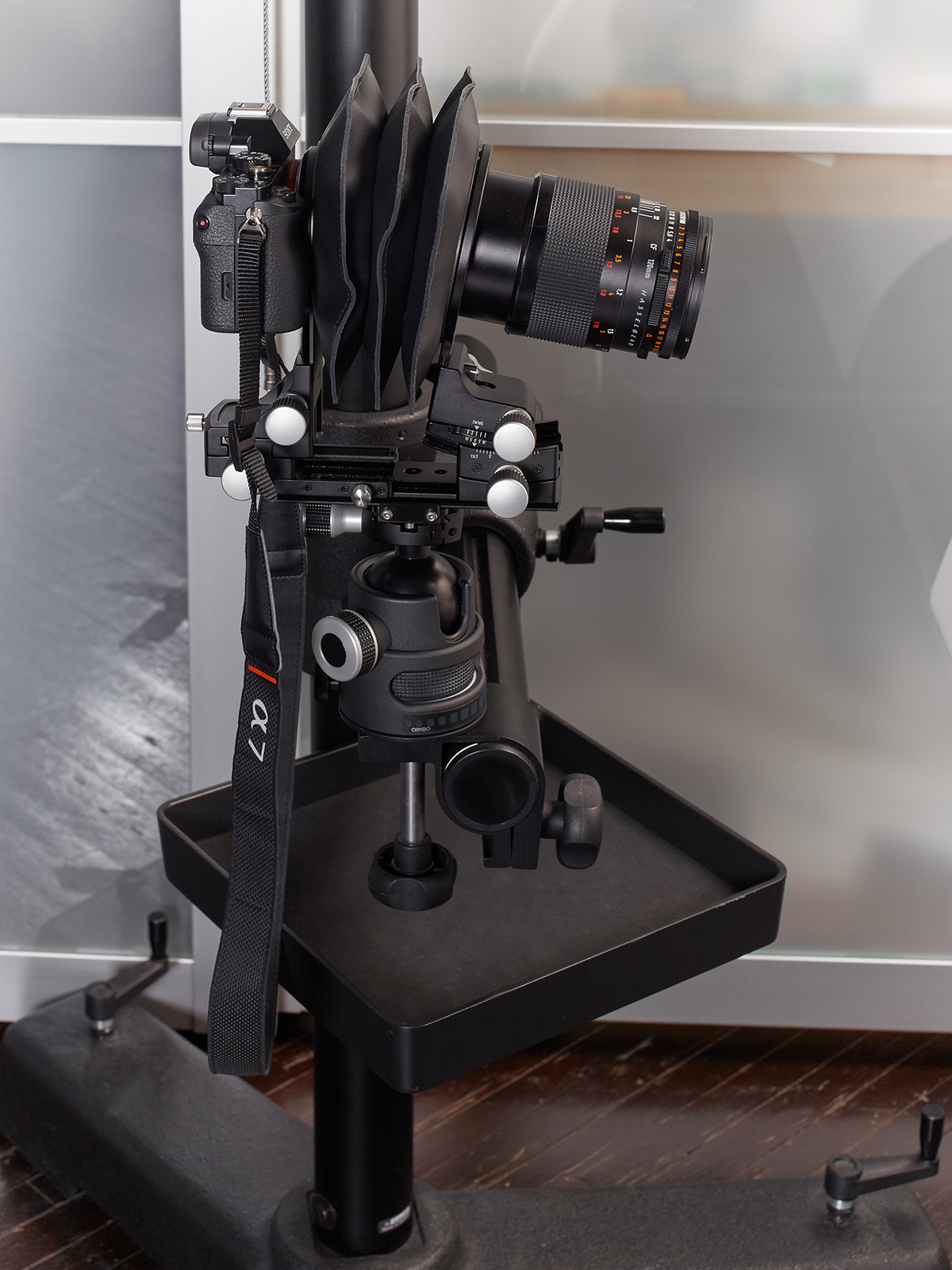
Cambo Actus Camera on Cambo CBH-6 Ballhead on Cambo Mono-1 Camera Stand
The Actus makes a great companion to a small format digicam like the Sony A7 series, or even the Fuji X cameras. It extends their usability, helps open that world up to a wide variety of killer lenses with movements – all while maintaining that miniature footprint – and provokes your sense of “Yes I can!”. So for now, well….what are you waiting for? Don’t you want to have some fun?
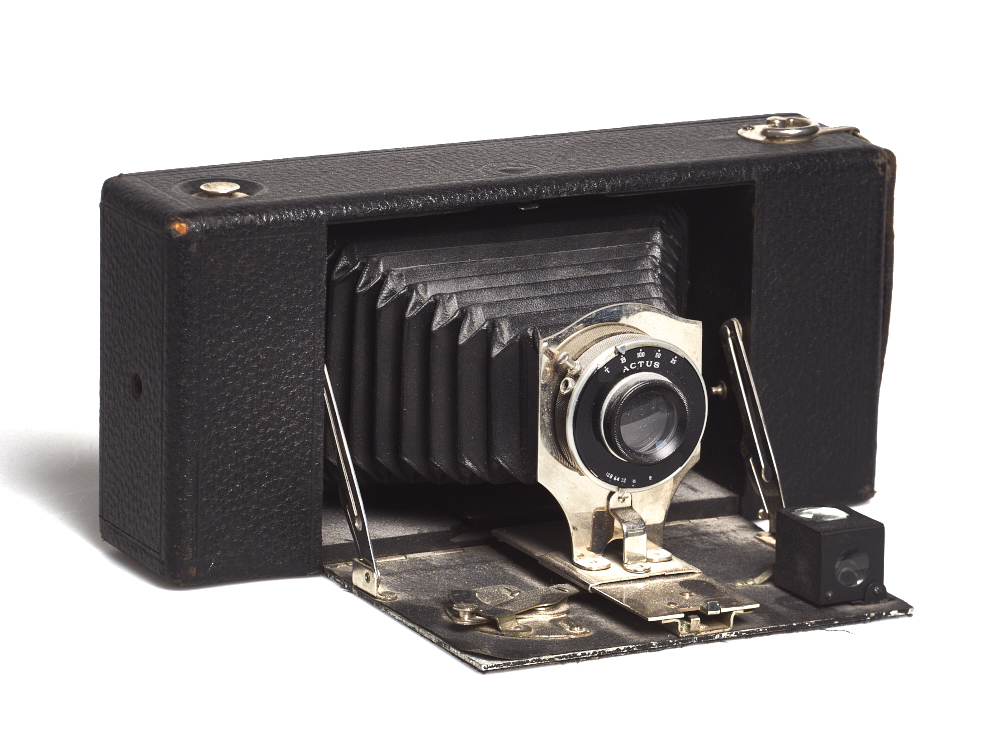
Very old Actus meets very NEW Actus
And right now is actually a smashing good time to grab a Cambo Actus along with a Sony A7R camera bundle at a special price through August 31, 2014.
http://205.186.138.113/plesk-site-preview/captureintegration.com/205.186.138.113/cambo-actus-and-sony-a7r-bundle/
| Product | Part | Advised Pricing |
| Cambo ACTUS camera body BLACK (no mount) | ACTUS-B | 1,990 |
| Cambo ACTUS camera body TITANIUM (no mount) | ACTUS-T | 2,089 |
| Cambo ACTUS camera body BLACK (+ Sony E- mount)* | ACTUS-B6 | 2,070 |
| Cambo ACTUS camera body TITANIUM (+ Sony E- mount)* | ACTUS-T7 | 2,169 |
| Cambo ACTUS camera body BLACK (+ Canon EOS body mount) | ACTUS-B2 | 2,070 |
| Cambo ACTUS camera body TITANIUM (+ Canon EOS body mount) | ACTUS-T3 | 2,169 |
| Cambo ACTUS camera body BLACK (+ Nikon F body mount) | ACTUS-B4 | 2,070 |
| Cambo ACTUS camera body TITANIUM (+ Nikon F body mount) | ACTUS-T5 | 2,169 |
| Cambo ACTUS camera body BLACK (+ Fuji X mount) | ACTUS-B8 | 2,070 |
| Cambo ACTUS camera body TITANIUM (+ Fuji X mount) | ACTUS-T9 | 2,169 |
| | | |
Note: ACTUS camera bodies do NOT include a lens plate
Note: ACTUS camera bodies do include bellows | | |
| | | |
| Standard bellows (150mm extension) | AC-210 | 329 |
| Wide Angle bellows (40mm extension) | AC-212 | 329 |
| | | |
| Lensplate with #0 hole (black finish) | ACB-0 | 159 |
| Lensplate with m39 threading (black finish) | ACB-39 | 169 |
| Lensplate with Leica-R bayonet (black finish) | ACB-LR | 339 |
| Lensplate with Hasselblad bayonet (black finish) | ACB-HA | 339 |
| Lensplate with Mamiya RB-RZ bayonet (black finish) | ACB-RZ | 475 |
| Lensplate with Nikon F-lens bayonet (black finish) | ACB-NF | 339 |
| | | |
| Lensplate with #0 hole (titanium finish) | ACT-0 | 167 |
| Lensplate with m39 threading (titanium finish) | ACT-39 | 177 |
| Lensplate with Leica-R bayonet (titanium finish) | ACT-LR | 356 |
| Lensplate with Hasselblad bayonet (titanium finish) | ACT-HA | 356 |
| Lensplate with Mamiya RB-RZ bayonet (titanium finish) | ACT-RZ | 499 |
| Lensplate with Nikon F-lens bayonet (titanium finish) | ACT-NF | 356 |
| | | |
| Rear Standard suitable for 32HR/35HR/40HR/35XL/43XL | ACB-310 | 999 |
| (non-rotating bayonet mount) / (black finish) | | |
| Rear Standard suitable for 32HR/35HR/40HR/35XL/43XL | ACT-311 | 1049 |
| (non-rotating bayonet mount) / (titanium finish) | | |
| ACB-310 and ACT-311 include an integrated WA-Bellows | | |
| | | |
| Bayonet Kit for Canon Eos body included in Canon mount kit | AC-780 | 80 |
| Bayonet Kit for Nikon F mount body included in Nikon mount kit | AC-783 | 80 |
| Bayonet Kit for Sony E mount body included in Sony mount kit | AC-786 | 80 |
| Bayonet Kit for Fuji X mount body included in Fuji mount kit | AC-790 | 80 |
| Bayonet Kit for Micro Four-Third body | AC-788 | 80 |
[gravityform id=”32″ title=”true” description=”true”]